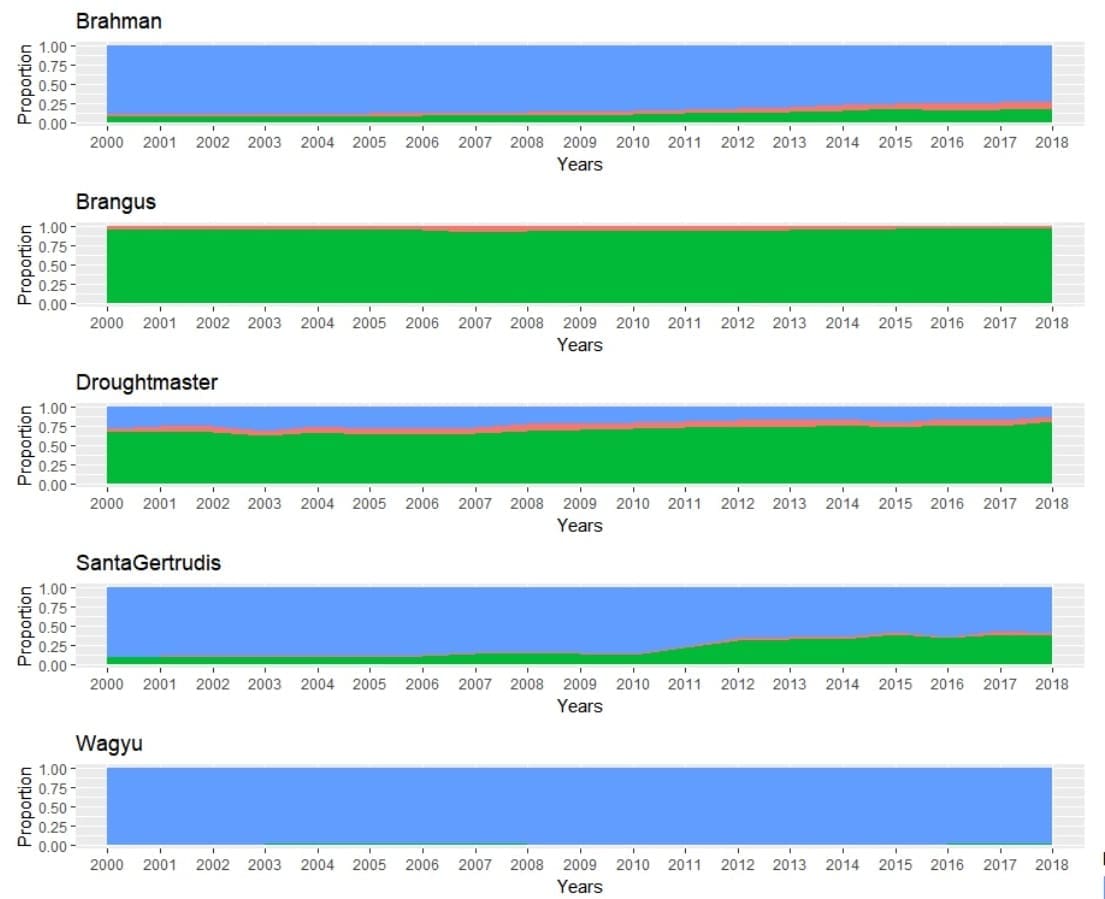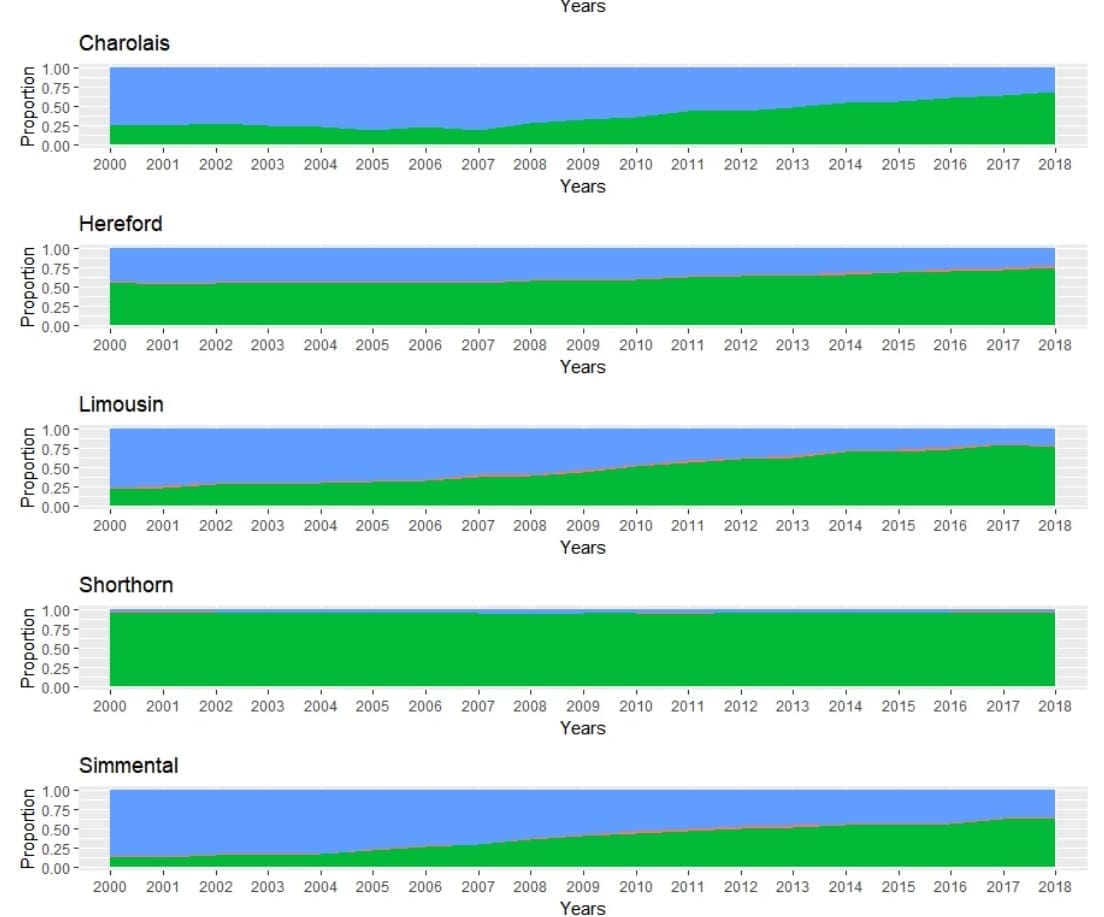A recent research report into Improving the Australian Poll Gene Marker Test contained an interesting comparison of ten popular beef breeds, looking at horn status change over 18 years from 2000 to 2018.
The comparisons were based on BreedPlan data between 2000 and 2018. Note that these results are based on seedstock animals, and do not represent commercial cattle which will inevitably be multiple generations behind, in their genetic progress towards polledness.
There are clear social benefits in terms of both animal welfare and workplace safety for personnel, together with economic benefits (reduced calf mortality and reduced labour costs) from breeding naturally polled herds, the report said (click here to access).
As the graphs published from the report below show (click on images for a larger view), there are significant differences in progress towards polledness from breed to breed over the past two decades.
Head status: Blue = Horn, Orange = Scur, Green = Poll
The graphs show breeds like Santa Gertrudis have made big inroads, especially in the past ten years (roughly equating to the arrival of the first DNA Poll Gene market test). Charolais, Simmental and Limousin, also, have made sold selection progress over the past decade, the graphs show.
While Droughtmaster was already starting from a relatively high base (the graph suggests about two-thirds of bulls were already polls, two decades ago), progress continues to be made.
While making some progress over the past 20 years, Brahmans still carry less than one-third of cattle with either scurs or polls. In fact Brahmans has easily the largest scurred population (orange line) among all ten breeds listed.
Missing from the list of major breeds, of course, is Angus, which is already 100pc polled. An unusual inclusion is Wagyu, which in their Japanese Fullblood state, are 100pc horned cattle. The thin green (polled) line for the Wagyu entry in the graph is a reference to a small number of ‘purebred’ animals, bred up through crossbreeding from other breeds. It’s worth noting, however, that many Wagyu brand programs insist on the use of Fullblood bulls only in an animal’s pedigree.
Shift in attitude over horns
The research report noted that with developments in the intensity and practices of raising beef cattle over time, the desirability of horns has changed. Generally, in the modern commercial cattle industry, horned animals are less desirable because they pose potential hazards for other cattle and animals used for mustering (horses, dogs), feeding, handling and transport facilities, and farmworkers.
Horns are associated with higher costs of on-farm and post-farm production and greater risk of reduced meat and hide quality. While dehorning or disbudding is a common practice to reduce these issues on-farm, all surgical, chemical and cautery procedures are costly and cause varying degrees of pain and reduced animal welfare, morbidity, mortality and reduced productivity.
As animal welfare becomes more important as production and consumer consideration, there is also economic and social license considerations, the report noted. Polled cattle have become more desirable and an increasing trend of producing polled animals in various breeds in Australia have been noticed.
Selective breeding for polled animals requires accurate early-in-life prediction of horn phenotype. The underlying genes and causal mutations for horns, scurs and polledness remain to be fully understood, however.
The earliest Poll tests utilised in Australia were based on combinations of ten microsatellite markers mapped to the relevant region on a chromosome. Between 2010 and 2013, a single microsatellite marker was used as a commercial test for polledness, developed by CSIRO and the Beef Cooperative Research Centre.
A second version utilising ten markers was implemented in 2014 to overcome issues including poor accuracy rates for Bos taurus breeds, such as Limousin and Brangus (39pc and 38pc accuracy respectively). This refinement was successful in improving the accuracy of the test across a large range of breeds and became to standard Australian commercial test until 2018. It proved to be a world-leading initiative for the selection and breeding of increased polledness in the Australian herd for many breeds.
OPT Test
A recent research project investigated the tests available for analysing the poll gene across common beef breeds in Australia to develop an Optimised Poll Test (OPT). Research also analysed genetic markers associated with scurs and determined whether there are negative effects of the poll gene on reproductive performance.
The OPT test developed in the project has increased the efficiency of poll prediction by 9pc.
Results also confirmed that polledness will have no detrimental effects on herd productivity or reproductive performance.
Despite the availability of a commercial DNA test to the Australian beef industry, testing for poll genes in beef cattle is currently not widely adopted, the report noted.
In some cases there is uncertainty about the effect of the scur gene and the assumption that polledness is associated with inferior genetics for reproductive traits.
The primary objective of the project was to develop an improved poll test suitable for future large-scale herd analysis. This would provide a cost-effective and reliable method to accurately assess the poll status and its impact on major cattle breeds in Australia. The new OPT increased the poll prediction efficiencies from the current level of 90.31pc to 99.6pc and has a commercial poll testing success rate of 99.42pc.
The study confirmed that there is no significant difference in fertility or other traits in polled versus horned animals, therefore, polledness should not be considered detrimental to breeding objectives.
Although scurs remain poorly understood, data shows the trait is predominantly observed in animals with higher genetic variation, and is more likely to occur in males than females. Results indicated that if polled animals are selected over a few generations, scurs and horns will decline in the herd.
While one can argue that scurs is less of an economic and welfare issue within herds, the presentation of scurs is often indistinguishable from horns at an early age and industry practice would be to remove (dehorn or disbud) scurs at earliest convenience.
Further research to understand the frequency and heritability of scurs in Australian herds will hopefully better predict scurs within herds will benefit the industry, the report said.
Polledness is in some producers’ minds was linked to reproductive deficiencies, the report said.
Polledness effects on production and reproduction
Previous research on the impact of polledness on production and fertility traits of different breeds and crossbred cattle have generally shown no significant difference for production traits, including liveweight, growth rate, carcase weight and quality, dystocia, fertility and mortality rates, the report said.
Results in the current project, based on the estimated breeding values (EBVs), generally supported those previous findings. Even when some sustained trends showed significant differences, these were of little practical impact as had very small effect sizes. Moreover, several EBVs trends were not consistent towards one or other phenotype (polled or horned) across all breeds and may indicate head-status is not a direct cause for differences observed.
Interestingly, reproduction (scrotal size, gestation length, days to calving, calving ease and sperm quality) and behaviour (flight time and docility) traits have consistently shown better genetic merit for polled cattle.
Another promising observation in favour of poll breeding was that the polled animals that had lower EBVs at early age (birth weight and subsequent growth to weaning) showed above average EBVs for later growth and became as good as, or better than their horned contemporaries, which was consistent with previous research.
“An increased prevalence of polledness within herds or industry-wide would not be expected to have a measurable negative influence on production, carcase, fertility and behaviour traits,” the report concluded. The greater risk was in loss of diversity or inbreeding effects in breeds with few polled animals (such as Brahman, Santa Gertrudis and Wagyu), and this would need to be managed carefully until there are larger numbers of polled breeding bulls and cows.
Fortunately, breeding high genetic merit polled animals has become a realistic perspective with the help of new tools being used for genomic selection and precision breeding. Gene editing technologies (e.g. CRISPR) may also have a role to play in introducing more genetic diversity into these herds, depending upon federal regulations.



Very interesting seeing the difference in progress between breeds. I am not sure how much longer we as an industry can keep dehorning cattle. I am also curious to understand where the Brahman breed is up to with the additional challenge of a more complex gene relationship with polled heritability and what the future holds for the breed if this cannot be overcome quickly?
Thank you for this very informative article.
I appreciate the access to this industry breed information and I am comfortable that your source of data is very sound.
My observation is that most beef breeders’ concerns around introduction of polls are based around the negative influence on another important traits. In most breeds this seems to be relating to loss of weight or ‘bone’.
I suggest that there are some confounding factors influencing the general sentiment around introduction of the Poll trait into all breeds over the years.
The article touches on the issue of ‘purity’ in the Wagyu breed in particular and I agree that this argument does have merit to those who wish to maintain 100 % content status.
In my case, I can say with Wagyu, the introduction of the Poll gene has not had a negative effect on carcass weight nor marble, which are our primary profit drivers. Weight has in fact increased in our Polled crossbred cattle.
Due to the ability to introduce desirable traits from other breeds ,Wagyu crossbred Polled cattle have become more profitable for us.
Whilst I welcome the day that de-horning is not required in our herd, the pursuit for Polled cattle is still ranked below fertility, temperament and meat quality in our selection criteria.
Thanks for your comment, Darren. It appears that the Wagyu industry is dividing into two camps, along brand program lines: Those who see value in the word ‘Fullblood’, and those who are simply pursuing abundant marbling, where outright breed purity is less of an issue. The makret obviously sees value in both. Might make the basis of an interesting story some time. Editor